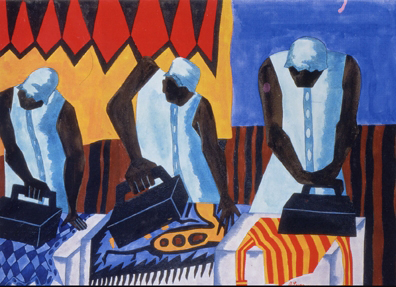
IRONERS by Jacob Lawrence, as seen in Manfred Kirchheimer's ART IS...THE PERMANENT REVOLUTION (Artists Rights Society, New York)
Veteran documentarian Manfred Kirchheimer (most recently 2007’s Spraymasters) employs the folk anthem “Which Side Are You On” in his newest film, assuming you’re already sympathetic to the causes that will be championed. The octogenarian German-born and NYC-trained cameraman/director has even foregone much of an explanation for what the “revolution” in the title even means. It’s not quite an error, but more likely a conceit to the well-informed audience seeing this modest essay film that pairs three modern-day printmakers with interludes on the history of the printmaking art.
Featuring the work of dozens, including compatriots Otto Dix and Käthe Kollwitz, Kirchheimer features frame after historic frame of the work of some of the most talented and influential artists ever to put acid to copper, grease to stone, or to delicately carve and ink a woodblock. In today’s era of massive, instantaneous digital replication, it’s easy to forget that at one time, it took a great effort to reproduce an image. Kirchheimer’s intimate interviews with a working woodcutter, lithographer, and etcher remind us of this. And somewhere in the midst of this mini-lesson, we start to understand the social importance of printmakers.
The film sticks to a pretty basic game plan, though. Every time we hear Deborah Schneer’s made-for-PBS narration, we know what’s coming. She describes Daumier, Rembrandt, Goya, Rembrandt, and many more as talented and sought-after artists in their time, who died in poverty or in abject circumstances, thanks to a passionate need to advocate for social justice, unfavorable as it may have been at the time or to their livelihoods. Watching this film, you might believe that to be a socially conscious artist, one must suffer. Not true, yet Kirchheimer is far from a revisionist historian in his categorization. This film describes the starving artist versus a misunderstanding and opportunistic society—about as basic a struggle as there is.
For art historians, this survey probably just grazes the surface. For activists, the social theory here is probably likewise pretty tame. Perhaps for the one percent, there’s an ethnographic fascination in the class struggle throughout history. For the rest of us 99 percent, I’d expect there’s something to be learned, if nothing more than that it’s not just art that is a permanent revolution, but that perhaps art merely records a struggle that is never going to go away.
















Leave A Comment